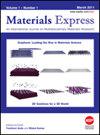Effect of solution temperature on the microstructure and properties of ceramic coating on the surface of 2024 aluminum alloy
IF 0.7
4区 材料科学
Q3 Materials Science
引用次数: 0
Abstract
This study investigates the influence of the 2024 aluminum alloy was treated with solution before ceramic treatment on the microstructure and characteristics of ceramic coatings applied to 2024 aluminum alloy substrates. The microhardness, corrosion resistance, and microstructural properties of these ceramic coatings were assessed using a microhardness tester, an electrochemical workstation, and a scanning electron microscope. The findings indicate that pre-treatment involving solution treatment significantly enhances the hardness and corrosion resistance of 2024 aluminum alloy ceramic coatings. Notably, when the solution temperature was maintained at 460 °C, the most rapid decrease in current density was observed during the ceramization process, resulting in the attainment of the lowest final stable current density. This particular condition yielded ceramic coatings with optimal hardness and corrosion resistance, with hardness exhibiting a remarkable increase of 48.9 HV, self-corrosion potential rising by 0.207 V, and polarization resistance surging by 5310.7 Ω. Moreover, the surface of the ceramic coating displayed remarkable smoothness and was devoid of discernible defects such as cracks or looseness. In light of these findings, it can be concluded that the optimum solution temperature for achieving these desirable properties is 460 °C. This conclusion is derived from a comprehensive analysis encompassing both the morphology and corrosion resistance of ceramic coatings.溶液温度对 2024 铝合金表面陶瓷涂层微观结构和性能的影响
本研究调查了 2024 铝合金在进行陶瓷处理前用溶液处理对 2024 铝合金基材上陶瓷涂层的微观结构和特性的影响。使用显微硬度计、电化学工作站和扫描电子显微镜评估了这些陶瓷涂层的显微硬度、耐腐蚀性和显微结构特性。研究结果表明,通过溶液处理进行预处理可显著提高 2024 铝合金陶瓷涂层的硬度和耐腐蚀性。值得注意的是,当溶液温度保持在 460 ℃ 时,在陶瓷化过程中观察到的电流密度下降最快,从而达到最低的最终稳定电流密度。在这种特定条件下,陶瓷涂层具有最佳的硬度和耐腐蚀性,硬度显著提高了 48.9 HV,自腐蚀电位上升了 0.207 V,极化电阻飙升了 5310.7 Ω。此外,陶瓷涂层表面非常光滑,没有裂缝或松动等明显缺陷。根据这些研究结果,可以得出结论:实现这些理想特性的最佳溶液温度为 460 ℃。这一结论是通过对陶瓷涂层的形态和耐腐蚀性进行综合分析得出的。
本文章由计算机程序翻译,如有差异,请以英文原文为准。
求助全文
约1分钟内获得全文
求助全文
来源期刊

Materials Express
NANOSCIENCE & NANOTECHNOLOGY-MATERIALS SCIENCE, MULTIDISCIPLINARY
自引率
0.00%
发文量
69
审稿时长
>12 weeks
期刊介绍:
Information not localized
 求助内容:
求助内容: 应助结果提醒方式:
应助结果提醒方式:


